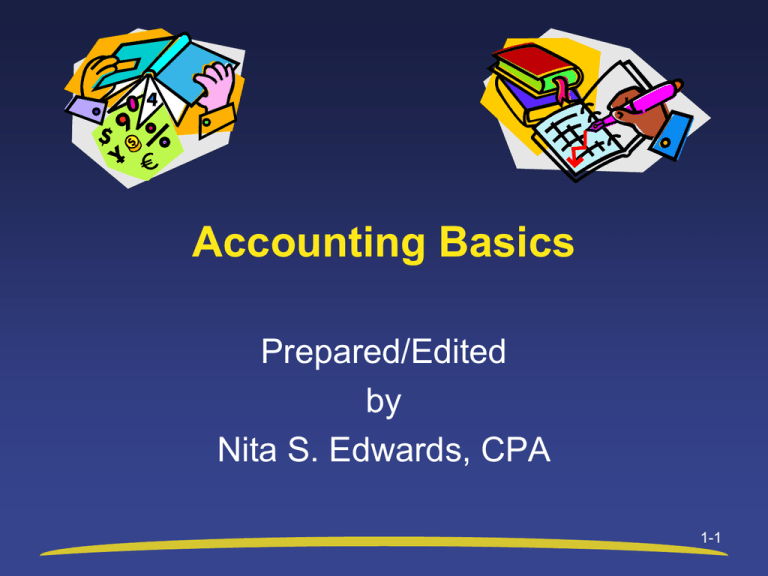
Accounting Basics
Prepared/Edited
by
Nita S. Edwards, CPA
1-1
The Language of Business
• Accounting is an information system
Measures business activities
Processes data into reports
Communicates results to people and
organizations
• Accounting is used to make decisions
1-2
Users of Accounting
Individuals
Taxing
Authorities
Investors
&
Creditors
Nonprofit
Organizations
1-3
Financial and Management
Accounting
FINANCIAL
• Provides
information for
external users:
Investors
Bankers
Government
agencies
MANAGEMENT
• Provides
information for
internal users:
Managers of the
company
1-4
GAAP
• GAAP is an acronym for Generally Accepted
Accounting Principles
• U.S. GAAP is formulated by the Financial
Accounting Standards Board (FASB)
• FASB’s Conceptual Framework states that
accounting should be:
Relevant
Reliable
Comparable
Consistent
1-5
Copyright ©2008 Pearson Prentice Hall. All rights reserved
Debits and Credits
• Debit – Entry on the left side of an account –
Will increase an account with a Normal Debit
Balance
• Credit – Entry on the right side of an account –
Will increase an account with a Normal Credit
Balance
Cash
Debit
Credit
1-6
Assets – Balance Sheet – Permanent
• Economic resources that provide a future
benefit
• Examples:
Cash
Inventory
Equipment
Land
Buildings
1-7
Liabilities – Balance Sheet - Permanent
• Outsiders claims to assets
Include debts payable to creditors
• Examples:
Accounts payable – liability for goods or
services purchased on credit
Notes payable – written promise to pay on a
certain date (bank loan)
1-8
Owners’ Equity – Balance Sheet - Permanent
• Owners’ claim on a business
• Includes Initial Investments less
Withdrawals/Dividends and Retained
Earnings
• Retained Earnings is the accumulation of
Net Income/Losses.
• A corporation’s equity is called
Stockholders’ Equity
1-9
Revenue – Income Statement - Nominal
•
•
•
•
•
Sales from Merchandise or Services
Presented on the Income Statement
Closed at the end of the Period
Normal Balance is a Credit
Examples:
Rent Revenue
Service Revenue
Sales Revenue
1-10
Expenses – Income Statement - Nominal
•
•
•
•
•
Costs of doing business
Presented on the Income Statement
Closed at the end of the Period
Normal Balance is a Debit
Examples:
Salaries Expense
Utilities Expense
Insurance Expense
1-11
Net Income
• Revenue – Expenses = Net Income or Net
Loss
• Net Income/Loss Reported on Income
Statement
• Net Income/Loss is included in Retained
Earnings
1-12
The Accounting Equation
Liabilities
=
+
Owners’
Equity
1-13
Accounting Equation
Assets = Liabilities + Owners’ Equity
Or
Assets – Liabilities = Owners’ Equity
Assets are either owned by the Creditors
(Liabilities) or Investors (Equity).
The Equation must always balance.
1-14
Accounting Equation Example
Assets =
Liabilities +
Owners’ Equity
(a)
$70,000
$50,000
$20,000
(b)
$30,000
$20,000
$10,000
(c)
$40,000
$15,000
$25,000
1-15
The Accounting Cycle
•
•
•
•
•
•
•
•
Journalize Transactions
Post to General Ledger
Prepare Trial Balance
Complete Adjusting Entries
Prepare Adjusted Trial Balance
Prepare Financial Statements
Close Permanent Accounts
Post Closing Trial Balance
1-16
The Financial Statements
• Report company’s results to the public
• Four Statements
Income Statement
Statement of Retained Earnings
Balance Sheet
Statement of Cash Flows
1-17
The Income Statement
• Measures operating performance for the
period
• Reports revenue and expenses and
resulting net income (or loss)
• Also includes gains and losses
1-18
Statement of Retained Earnings
• Shows increases and decreases to
retained earnings
• Increase: net income
• Decrease: dividends
1-19
Balance Sheet
• Measures financial position
• Reports assets, liabilities and
shareholders’ equity
• Assets and liabilities are categorized
Current and Long-term
1-20
Balance Sheet Categories
• Current assets
Converted to cash or used within one year
Cash, Short-term Investments, Accounts
Receivable, Inventory
• Long-term
Property, plant, and equipment
Intangible assets
Investments
Other
1-21
Balance Sheet Categories
• Current liabilities
Due within one year of balance sheet date
Accounts payable, salaries payable, taxes
payable, short-term borrowings
• Long-term liabilities
Long-term notes payable, mortgage payable
1-22
Balance Sheet Categories
• Stockholders’ Equity
Paid-in capital
• Common stock
Retained Earnings
1-23
Statement of Cash Flows
• Shows inflows and outflows of cash by
category:
Operating activities
Investing activities
Financing activities
1-24
Cash Flow Categories
• Operating
Cash generated from day-to-day business
activities
Related to selling goods and services to
customers
• Investing
Cash invested in long-term assets
Related to purchasing and selling plant assets
and investments
1-25
Cash Flow Categories
• Financing
How a company obtains resources to finance
business
Related to long-term debt and equity (issuing
stock)
1-26
Relationships of Financial
Statements
• Net Income (bottom line of Income
Statement) flows to Statement of Retained
Earnings
• Ending Retained Earnings flows to
Balance Sheet
• Cash balance from Balance Sheet flows
Statement of Cash Flows
Financial Statements should be prepared in
order since the amount on one statement flows
the next
1-27
INCOME STATEMENT
NET
INCOME
RETAINED EARNINGS
STATEMENT
ENDING
RETAINED
EARNINGS
BALANCE SHEET
ENDING
CASH
STATEMENT OF
CASH FLOWS
1-28
Reference
Harrison, W.T., Horngren, C.T. and Thomas,
B. (2009). Financial accounting, 8th
edition. Boston, MA: Pearson PrenticeHall.
1-29
Questions?
1-30







